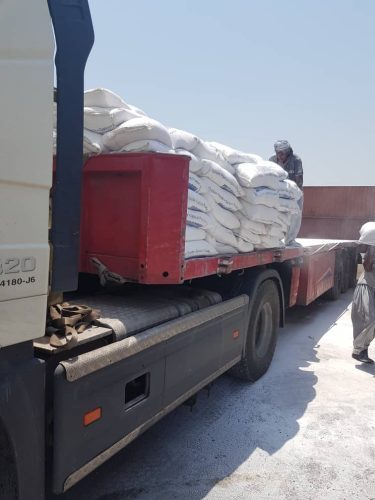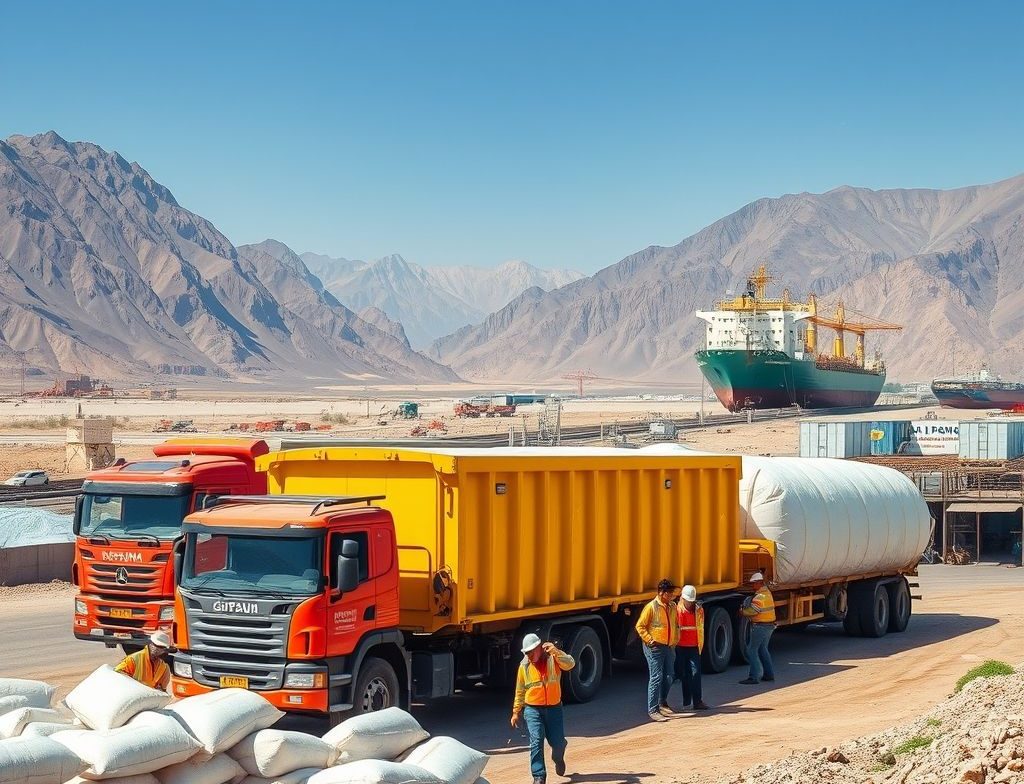Exporting GYPSUM from Iran to India: The Definitive SEO Guide
Exporting GYPSUM from Iran to India presents a unique trade opportunity. This guide delivers in‑depth insights on market trends, shipment data, pricing, regulatory frameworks, logistics, challenges, and SEO best practices—crafted for export companies, trade analysts, and B2B marketers.
Why Exporting GYPSUM from Iran Makes Strategic Sense
Iran is among the top gypsum producers globally, alongside the United States and China, accounting for about 31% of global production in 2024 Seair+4Volza+4Volza+4IndexBox. Its gypsum and anhydrite industry reached approximately US $382 million in market size in 2024, growing modestly year‑on‑year Trading Economics+2IndexBox+2Trading Economics+2.
Historically projected exports from Iran are expected to rise from 5.11 billion kg in 2021 to about 6.28 billion kg by 2026, at a compound annual growth rate of ~3.2% ReportLinker.
These figures underline Iran’s capacity and competitiveness in Exporting GYPSUM at scale.
India’s Demand: Why It Dominates as a Destination for Exporting GYPSUM
Among destinations for Iranian gypsum exports, India leads decisively. In 2023, Iran exported US $61.1 million worth of gypsum, with US $18.1 million going to India—making India the top market globaltradealert.org+15The Observatory of Economic Complexity+15Volza+15.
In terms of volume, during the trailing twelve months (Oct 2023–Sep 2024), India received 626 shipments from Iran—accounting for 93% of Iran’s gypsum exports in that timeframe Volza+1Volza+1.
This overwhelming share solidifies India as the primary destination for Exporting GYPSUM from Iran.
Export Volume and Shipment Trends
-
Between October 2023 and September 2024, Iran exported approximately 1,467 shipments of gypsum; 626 of those went to India, marking a 54% year‑on‑year increase in exports overall Volza.
-
India‑bound gypsum shipments grew by 74%, with 54 Iranian exporters supplying Indian buyers—around 40 buyers involved Volza.
This data evidences a robust and rising trade corridor for exporting GYPSUM from Iran to India.
HS Codes, Classification & Anti‑Dumping Regulations
Gypsum trade requires accurate HS classification:
-
HS 2520: Gypsum; anhydrite; plastering materials
-
HS 25202010: Calcined gypsum powder or gypsum plaster Seair+5IndexBox+5Trading Economics+5Trading Economics+5Volza+5taxmanagementindia.com+5
India has imposed anti‑dumping duties on calcined gypsum imports from Iran (and other countries) since December 2021. Negin Falat Pars Industrial Mining Co. exports are subject to a reference price of US $82.73/MT, while others face up to US $102.66/MT duties
Understanding these duties is vital when structuring pricing and export terms for Exporting GYPSUM.

Pricing Patterns & Financial Indicators
-
Average export price from Iran reached about US $25 per ton in 2024, rising 2.6% over the prior year.
-
India’s imports of gypsum and related products from Iran reached US $29.2 million in 2024 Trading Economics.
These benchmarks are essential for exporters to negotiate contracts competitively in the context of Exporting GYPSUM.
Step‑by‑Step Process for Exporting GYPSUM from Iran to India
Identify Product Variant
Choose between raw gypsum, gypsum powder (calcined), or plaster—classifying under HS 2520 or 25202010 as appropriate.
Confirm Production & Supply Capacity
Iran’s gypsum production and export capacity are projected to expand through 2026 (up to 6.28 billion kg)
Market Research & Buyer Identification
Use platforms like Volza to find Indian buyers, shipment history, and supplier profiles (e.g. 54 Iranian exporters, 40 Indian buyers, 626 shipments)
Price Negotiation & Duty Assessment
Benchmark price around US $25–30 per ton, factor in anti‑dumping duties—especially for calcined gypsum (up to ~US $103/MT reference price) taxtmi.comglobaltradealert.org.
Documentation & Certifications
Essential documents include: commercial invoice, packing list, certificate of origin, quality or safety certificates, and compliance with HS code requirements.
Logistics & Shipping
Key Iranian ports: Bandar Abbas, Bushehr. Choose cargo method (bulk vs container). Prepare for extended port/land transit planning.
Customs Clearance in India
Declare correct HS code, process anti‑dumping duty if applicable, pay import duties, and ensure local trucking or delivery is arranged.
Post‑shipment Follow‑up
Maintain quality, deliver timely, secure payments (via letter of credit), and nurture buyer relationships to enable repeat orders.
Market Outlook, Opportunities & Expansion Strategy
-
Exporting gypsum supports India’s construction and infrastructure boom.
-
Iranian gypsum competes well due to affordable pricing and consistent supply.
-
India’s domestic gypsum supply is limited (largely from Rajasthan) and logistics‑challenged in reaching major consumption zones—all of which enhances the demand for imports
To expand, exporters should target major consuming Indian states: Maharashtra, Gujarat, Karnataka, and partner with regional distributors or gypsum board manufacturers.

Common Export Challenges & How to Overcome Them
-
Regulatory compliance: Ensure accurate HS coding and anti-dumping duty calculation.
-
Documentation issues: Avoid delays by preparing full export/import files.
-
Logistics bottlenecks: Choose reliable transit agents and monitor port congestion.
-
Currency fluctuations & payment security: Use secure instruments like letters of credit or advance payment terms.
-
Trade policy changes: Stay up to date on Indian customs tariffs, import regulations, and any changes to anti-dumping measures.
Use Exporting GYPSUM in key headings, intro paragraphs, and sprinkled throughout body text—aim for natural flow and relevance.
Heading Strategy
-
Clear and concise with the keyword (“Exporting GYPSUM from Iran to India”).
-
Supporting subtopics (market, volume, HS codes, process, pricing, challenges, SEO).
-
Avoid over‑stuffing; each heading should capture a distinct aspect.
Content Quality
-
Provide data-driven insights, such as shipment volumes, export growth rates, duty levels, price benchmarks.
-
Use authority sources like Volza, TradingEconomics, IndexBox for citations.
Supporting Elements
-
Include internal links on your site to related pages (e.g. trade services, mineral exports).
-
Add a meta description:
Exporting GYPSUM from Iran to India – export volume data, HS codes, regulatory insights, pricing trends, logistics & SEO best practices.
User Engagement
-
Use bullet lists, numbered steps, and tables to present complex info clearly.
-
Provide actionable tips for exporters at each stage of the trade process.
Exporting GYPSUM from Iran to India remains a profitable opportunity reinforced by strong trade volumes, India’s reliance on imports, and Iran’s reliable supply and pricing. By understanding HS code compliance, duty obligations, pricing trends, and logistics, exporters can operate effectively. Pair this with an SEO-informed, data‑rich article layout, and your web content will not only attract search visibility but also convert B2B enquiries.
(FAQ)
1. What is gypsum powder used for, and how is it different from raw gypsum?
Gypsum powder, also known as calcined gypsum, is produced by heating raw gypsum to remove moisture. It’s primarily used in construction (plaster, drywall), agriculture (soil amendment), and manufacturing (ceramics, cement). Unlike raw gypsum stone, gypsum powder has greater versatility and faster setting properties, making it ideal for modern construction needs.
2. What is the current gypsum price in the global market, especially for Iranian exports?
As of 2024, the average gypsum price from Iran ranges between US $25–30 per ton, depending on the product form (stone vs powder), quality grade, and destination. Factors affecting gypsum price include transportation costs, global demand, anti-dumping duties (for powder exports), and exchange rates. Indian importers typically pay slightly more due to logistics and compliance.
3. What is gypsum stone, and why is it in high demand in India?
Gypsum stone is the raw mineral form extracted directly from quarries. In India, it’s in high demand for use in cement production, agricultural applications, and as a retarder in concrete. Due to limited domestic reserves and high logistical costs, India relies on imports—primarily from Iran—for high-purity gypsum stone at competitive prices.




